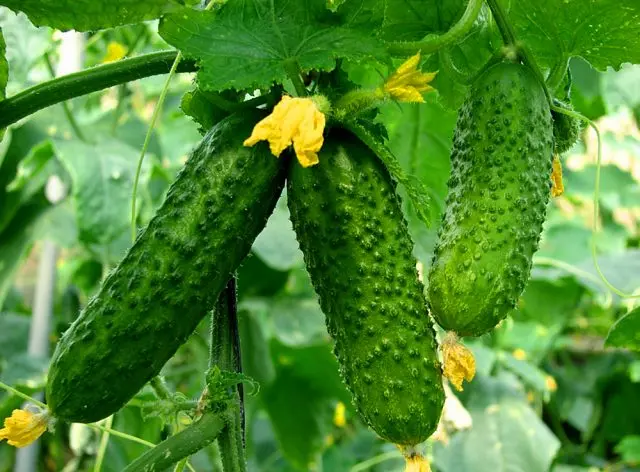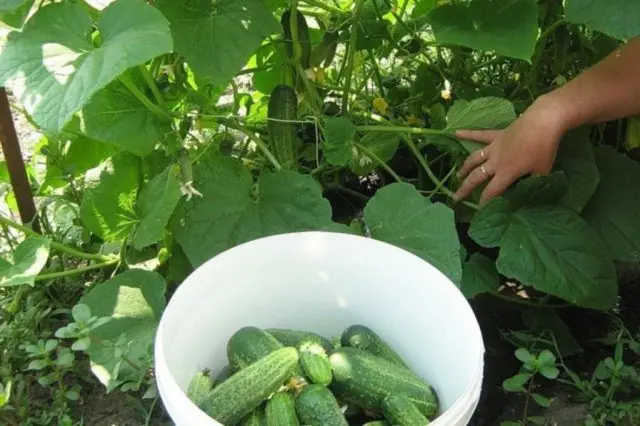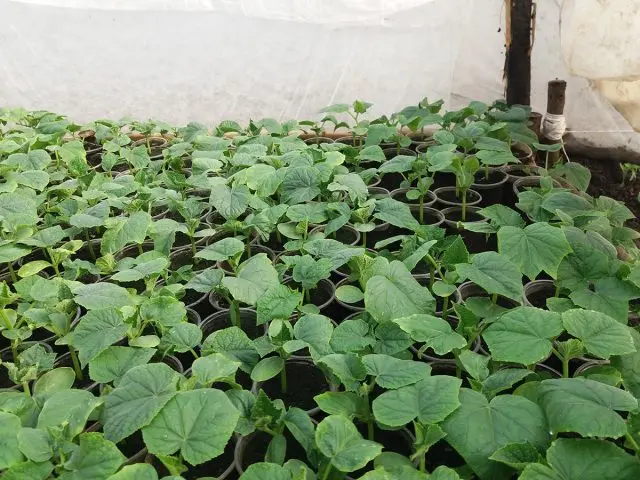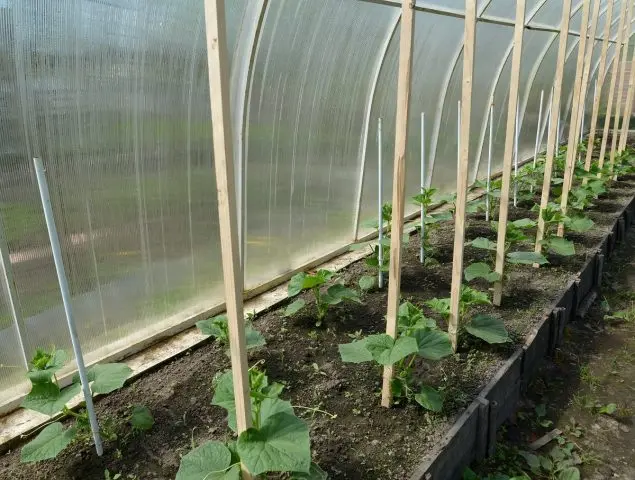Contents
Amur cucumber was bred by domestic breeders in the Moscow region at the turn of the last century. In 2000, he was noted in the State Register. The hybrid received many positive qualities from its predecessors and for several decades won the recognition of gardeners throughout the country. An early, plentiful and friendly harvest of delicious, beautiful Amur fruits is now being received from Krasnodar and the Crimea to Siberia and the Far East.

Description of cucumber Amur
Cucumber variety Amur F1 belongs to parthenocarpic cultures and does not need pollination. Therefore, it bears fruit well in open, protected ground or as a houseplant.
The bushes of the hybrid are vigorous, the branches are powerful, they develop according to the indeterminate type. When formed on supports, the lashes easily support the weight of the crop. Early fruiting occurs on the central shoot. The main stem with pouring cucumbers does not stop growing and does not give lateral shoots. After the end of the first wave of the harvest, short determinate shoots appear, on which several “bouquet” ovaries are laid.
The Amur cucumber variety does not require shaping, pinching, or constant tying. The bush is self-regulating and does not grow in breadth. The leaf plates of Cupid are medium in size, pubescent, with a classic green color for cucumbers. The edges of the leaves are even.
Description of fruits
Cucumber Amur F1, when characterizing fruits, is often referred to as gherkins, although it is able to grow very quickly up to 12-15 cm without losing its nutritional value and commercial qualities.
Varietal characteristics of the fruits of the hybrid Amur F1:
- length – up to 15 cm;
- the weight of an average cucumber is 100 g;
- the form is slightly fusiform, the neck is short;
- the peel is rich green, with light stripes;
- the surface is pubescent, tubercles on the skin are small, frequent;
- bitterness is absent, taste indicators are high.
Harvested cucumbers do not lose their presentation and taste for several days. Combined with a vigorous fruit yield, this makes the crop suitable for commercial cultivation. The use of fruits is universal: fresh consumption, cutting into salads, canning, salting. During heat treatment, voids are not found inside the timely removed Amur fruits.
Main characteristics of the variety
According to the characteristics and official description of the variety, Amur F1 cucumber is recommended for all regions of the country, subject to cultivation in protected ground. For spring-summer turnover in the open air, the hybrid is successfully used in the middle lane, but the full yield is noted only when grown in the south.
Of the characteristic features of the cucumber variety Amur F1 note:
- The ability to survive short-term droughts without losing ovaries, which is rare for cucumbers.
- Excellent return of fruits both in hot climates and in areas with cool summers.
- The F1 marking in the name indicates that the culture is hybrid and it will not be possible to get cucumbers from your own planting material.
- Amur shows itself well in film greenhouses and heated stationary greenhouses: almost all flowers form ovaries, bushes do not get sick.
Productivity of cucumbers Amur
One of the amazing qualities of the young Amur F1 hybrid is the ultra-early start of fruiting. For 35-40 days after the first shoots, the first cucumbers have time to start and form. At the same time, the return of the crop occurs amicably – in whole bunches. In one node, up to 8 fruits aligned in size are formed at the same time.

For commercial cultivation, the hybrid is sown twice a month apart, receiving a massive return of cucumbers without interruption for more than 60 days in a row.
In the official description, the declared yield of the Amur variety is about 14 kg per 1 sq. m. One plant on average brings 4-5 kg of fruit, taken at the gherkin stage. According to reviews of private producers and large farms, the variety, with proper care, gives up to 25 kg of excellent cucumbers per season. The most important influence on the fertility of Amur F1 bushes is the nutritional value of the soil and the frequency of irrigation.
Pest and disease resistance
The hybrid form received the best qualities from the parent varieties, including resistance to olive blotch, cucumber mosaic, and powdery mildew. Relatively not susceptible cucumber variety Amur F1 to fungal infections of the roots and downy mildew.
A good prevention of cucumber diseases is spraying with Fitosporin. The beds are shed with the same solution when preparing the site for the Amur variety.
Pests that threaten planting cucumbers:
- sprout fly;
- whitefly;
- spider mite;
- nematode;
- aphid.
To combat the onset of infection, specialized or systemic insecticides are used. Most often, drugs Aktara, Fufanon, Intravir, Iskra are chosen.
Pros and cons of the variety
Hybrid Amur F1 has a good reputation among experienced vegetable growers and is liked by beginners. Seeds have high germination, plants are unpretentious and hardy, and cucumbers have excellent taste.
Among the advantages of the variety are also noted:
- Cucumbers have an attractive presentation: the same size, dense bright peel, uniformity of shape.
- Rapid growth of green mass and ultra-early fruiting.
- Friendly return of fruits, convenient for the formation of trade parties.
- Possibility of long-term transportation, without loss of taste.
- No need to form a stem, pinch.
- Mature plants tolerate temporary cold snaps well.
Stretched fruiting and the ability to get a big harvest are also attributed to the advantages of the hybrid. As a drawback, only the exactingness of cucumbers for watering and top dressing is distinguished. With improper nutrition or irrigation, even persistent Cupid can lose some of the ovaries.
Growing rules
On open beds or in a greenhouse, the Amur variety can be planted with seedlings or seeds. You can grow cucumbers in the open air by direct sowing in the southernmost points of the country. A little closer to the central regions, Amur is already cultivated through seedlings. The closer to the north, the more relevant it becomes early sowing in separate containers with subsequent removal to the greenhouse.

Terms of sowing
Amur seeds can be placed in open ground no earlier than the soil warms up to + 15 ° C. For different regions, this period is significantly different.
Approximate planting dates for Amur F1 seeds:
- in the south, sowing is done in early May;
- in the middle lane, the optimum soil temperature is achievable by the end of spring;
- planting seedlings at home begins in mid-April;
- removal of young cucumbers to greenhouses or open ground is optimal at night temperatures of at least + 12 ° C;
- Amur is grown in heated greenhouses all year round, survival rate and yield are more dependent on illumination.
Cucumbers are heat-loving, tender plants that painfully endure contrasting temperatures. The optimal mode for growth and fruiting: above + 20 ° C during the day, not below + 12 ° C at night. Amur F1, as a super early variety, is more resistant to night coolness. And yet, with a sharp decrease in temperature, the beds are recommended to be covered with agrofiber.
Choosing a place and preparing beds
Principles for selecting a place for planting Amur cucumber:
- Sunny area or light partial shade.
- In the previous season, no cucurbits grew on this site.
- The best predecessors are onions, potatoes, tomatoes, legumes.
- Loose, fertilized, acid-neutral soil.
The high-yielding Amur variety will respond well to pre-fertilized soil. In autumn, 1 sq. m. area should be made up to 10 kg of manure, 50 g of superphosphate and 25 g of potash fertilizers. In the spring, ammonium nitrate is used (20 g per 1 sq. M.). It is useful to lay wood ash in the holes just before planting.
For the prevention of diseases and pests, it is good to shed the beds with a Bordeaux mixture (1 tablespoon of copper sulfate per 10 liters of water). The soil is cultivated at the rate of 2 liters per 1 sq. m.
How to plant
With the seedling method of growing, the sprouts of Amur cucumbers are ready for transplantation already 14 days after germination. Seedlings with 4 true leaves are considered mature. It is advisable to transfer plants to a permanent place no later than 35 days from sowing.
Weak branching of the cucumber allows you to thicken plantings up to 3-4 bushes per 1 sq. m, which significantly increases the yield. On an open bed with vertical shaping, seedlings of this variety can be compacted up to 5 bushes.

The distance between cucumber bushes is measured about 30 cm. Planting in a checkerboard pattern is possible. Every 2 lines leave an indent of 0,5 m. Plants of the Amur variety are buried in the holes along the cotyledon leaves and watered abundantly.
The seedless method of planting Amur involves the preparation of seeds, which greatly accelerates germination:
- hardening – at least 12 hours on a shelf in the refrigerator;
- germination – on a damp cloth in a warm room until sprouts appear;
- it is not required to disinfect and stimulate the germination of varietal seeds from large producers.
The hatched seeds of cucumbers are buried no more than 3 cm. After falling asleep the holes, they are well shed. It is advisable to cover the beds with a film until the bulk of the seeds germinate.
Aftercare for cucumbers
The cultivation of the Amur F1 variety frees the vegetable grower from the formation of bushes, but does not cancel the following stages of care:
- Watering. The soil on the beds under plantings of Amur should be constantly moderately moist. Increase watering during the flowering period, when cucumbers are poured, it is desirable to moisten the plantings every day.
- Loosening and weeding can be eliminatedь, mulching the beds with sawdust, grass residues, special garden materials. Thus, they prevent the drying of the soil, hypothermia of the roots at night.
- Feeding. Fertilize cucumbers at least three times per season. The first dressing is appropriate during the flowering period. Further fertilizer is produced as needed during fruiting.
For the full development of Amur F1 cucumbers, nitrogen, potassium and phosphorus compounds are required, as well as a number of trace elements. Therefore, it is easiest to purchase complex fertilizers and breed them following the instructions.
Cucumbers of the Amur F1 variety respond gratefully to foliar spraying with nitroammophos, urea or superphosphate mixed with magnesium sulfate (1 tsp dry mixture per 10 liters of water). Ash pollination is the easiest way to additionally feed and protect plantings from diseases.
Conclusion
Cucumber Amur is a young and very promising hybrid. Its varietal qualities make it possible to cultivate it under the most contrasting conditions, under the hot sun, in the greenhouses of Siberia. According to the description of gardeners, Amur F1 cucumber manages to give a crop even in the open field in the Urals. Early fruiting and resistance to major diseases make the variety one of the most popular among private gardeners, as well as large farms.









